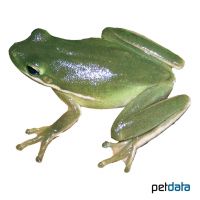American Green Treefrog (Hyla cinerea)
| American Green Treefrog Hyla cinerea | |
|---|---|
| Name | American Green Treefrog |
| Name Lat. | Hyla cinerea |
| Family | Hylids |
| Family lat. | Hylidae |
| Order | Frogs & Toads |
| Order lat. | Anura |
| Origin | North America |
| Habitat | Wetlands |
| Diet | Small live insects |
| Humidity | 60-70 % |
| Behavior | Peaceful, nocturnal |
| Keeping | Pair, group |
| Care Level | Easy |
| Breeding | Moderately difficult |
| Housing | Semi-humid terrarium |
| Life Span | 5 years |
| Protection | No |
| Metric Units | |
| Size | 6.5 cm |
| Temperature | 24-28 °C |
| Housing Size | 55 x 30 x 60 cm |
| US Units | |
| Size | 2.6" |
| Temperature | 75-82 °F |
| Housing Size | 20" x 10" x 25" |
Distribution and habitat
The range of the crepuscular to nocturnal American tree frogs is the southeastern United States, from North Carolina to Texas. The preferred habitat of these good climbers is trees and shrubs near standing or slow-moving water.
Maintenance
For 1-3 animals, the minimum terrarium area is 750 cm², with a minimum effective height (measured without substrate) of 40 cm. This corresponds to a base area of e.g. 30 x 25 cm. For each additional animal, provide an additional 200 cm² of surface area and 2 cm of height. The terrarium should be placed in a quiet place without sunlight.
You will need a terrarium with a substrate of loose, absorbent, non-rotting substrate such as. Sand-peat mixture, coconut fibers or Sphagnum moss with a drainage and a shallow watering place as large as possible, in addition branched climbing branches, preferably entwined by climbing plants, with horizontal perches, back and side wall coverings of e.g. tree fern plates (Xaxim) and a dense planting (e.g. Tradescantia, Ficus, Scindapsus, ferns). Potted plants that can be easily removed for cleaning are advantageous. At least twice a day the inside of the terrarium must be finely sprayed with water (humidity), but a rain or mist system is better
| Temp. day: 24-28 °C | Temp. night: 20-22 °C | Humidity: 60-70 |
The lighting duration must be 10-14 hours depending on the season. Daylight fluorescent tubes with low UV content are very suitable. Recommended is a hibernation of about 2 months, during which, depending on the origin of the animals, the temperature is lowered to 8-15 °C.
Diet
The food supply consists of live insects such as house crickets, houseflies and cockroaches as well as small grasshoppers and crickets. After a period of habituation (feeding with tweezers), special ready-made food is often accepted as well. Food should be offered to adult animals 2-3 times a week, young animals must be fed daily. It is important to add minerals and vitamins regularly (e.g. by dusting the food animals)
A varied diet promotes health and prevents deficiency symptoms.
Reproduction and breeding
Males have a whitish to yellowish sound bladder on the throat, which turns green during the mating season. After winter dormancy, the female, ready to spawn, is taken in the mating grip (amplexus) by the male and lays several hundred eggs, usually on plants directly on the water surface. Already after 4-6 days the larvae (tadpoles) hatch. They initially filter microorganisms from the water and later eat animal and plant food. After about 40-70 days the transformation (metamorphosis) is completed and the frog leaves the water.
The life expectancy can be 5 years.
Important
The American Tree Frog can change its body color depending on its environment, temperature or humidity. Its mucous membrane is very sensitive, accordingly it is necessary to pay attention to the necessary humidity.
Before purchasing, a terrarium should be prepared that meets the species specific needs. Necessary are good ventilation without drafts and devices for measuring temperature and humidity. The lighting has to correspond to the species-specific day-night rhythm and should be placed in such a way that the animals cannot injure themselves. The terrarium should be locked in such a way that neither unauthorized persons can open it nor the animals can escape. Special attention must be paid to thorough hygiene and impurities must be removed regularly
Further literature can be found in your pet store.
References
Text: petdata; Image: petdata
Source: ENGELMANN (2006): Zootierhaltung - Tiere in menschlicher Obhut: Reptilien und Amphibien, Harri Deutsch Verlag; VDA & DGHT (2006): Haltungsrichtlinien für die Haltung von Anuren
- Gemäß § 21 Abs. 5 Tierschutzgesetz idgF
